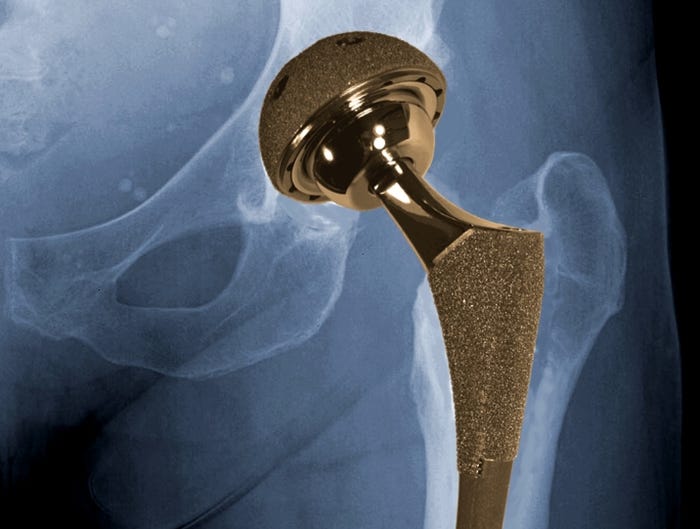November 17, 2013
Following years of negative publicity, metal-on-metal hip implants continue to make headlines. J&J recently settled a $4 billion metal-on-metal hip implant settlement and Biomet is now facing a patient lawsuit over its M2a Magnum hip implants.
|
The Biomet M2a Magnum hip implant |
First introduced to the market in 1997, metal-on-metal hip implants were hailed for their durability and were designed to last a lifetime. Early metal-on-metal implants were targeted to active, young patients who needed a device that could hold up for multiple decades. While all artificial hip implants can wear down over time, metal-on-metal hip implants carry a variety of unique risks.Failure rates for metal-on-metal hip implants are significantly higher than other devices (Cohen, 2012). While failure rates can vary by brand, the seven-year average failure rate for metal-on-metal hip implants is 13.6%. This compares with an average seven-year failure rate of 3.3% to 4.9% for hip implants manufactured from other materials.When an individual with a metal-on-metal hip implant walks or runs, the metal cup and the metal ball inside it slide against each other, generating a significant amount of friction. Over time, this movement can cause the release of tiny metal debris. In addition, corrosion between the taper of the step and the metal ball can also occur. Orthopedic surgeons take precautions to minimize the risk of this wear and tear, but there's no effective way to avoid the generation of all metallic debris over time. In many cases, metal-on-metal hip implants undergoing wear and tear will release chromium and cobalt ions. These ions can seep into local tissue near the site of an implant, potentially destroying bone and muscle. If these ions manage to enter a patient's circulatory system, they can injure the kidneys, liver, spleen and lymph nodes before they are eliminated from the body through urine.While cobalt is an essential element for proper health in most animals in small doses, in high doses, cobalt can lead to severe injury or death. Cobalt toxicity can lead to skin rashes, peripheral neuropathy, hypothyroidism, cognitive impairment, cardiomyopathy, hearing loss, and vision loss.While trivalent chromium, like cobalt, is an essential nutrient for proper human health, high blood serum levels of trivalent chromium can be dangerous for patients. Although trivalent chromium is only considered a probable carcinogen (unlike hexavalent chromium, a proven carcinogen), its presence in the body can be troublesome.In one study, patients who received a joint replacement were shown to have a three-fold risk of leukemia and lymphoma (Cohen, 2012).As early as 2005, some medical researchers were aware of the risk associated with metal-on-metal hip implants.
The manufacturers were aware of the potential for genotoxicity. The BMJ and Newsnight have seen a DePuy internal memo from July 2005, that says: "In addition to inducing potential changes in immune function, there has been concern for some time that wear debris may be carcinogenic. The mechanism is not known and only 24 local malignancies have been reported in patients with joint replacements. Also worrying is the possibility of distant effects. One study suggested a threefold risk of lymphoma and leukaemia 10 years after joint replacement. The metal to metal total hip appears to be quite promising and in the laboratory the data is (sic) definitely in its favour. However, the ultimate test is the long term human experience." (Cohen, 2012)
With yet another lawsuit alleging patient injuries, Biomet may soon be forced into a high-cost settlement like its rival J&J. As of now, the company faces hundreds of outstanding lawsuits over its metal-on-metal hip implants.The mass tort case against the Indiana company is represented by Bernstein Liebhard, a law firm. According to the firm, court documents related to the case were filed in the first part of November in the Superior Court of Justice in Ontario.
The allegations set forth in this Canadian case echo the experiences alleged by many of our own metal-on-metal hip implant clients in the United States, including recipients of the M2a Magnum hip.
ReferencesCohen, Deborah. "How safe are metal-on-metal hip implants?." BMJ: British Medical Journal 344 (2012).Clarke, M. T., et al. "Levels of metal ions after small-and large-diameter metal-on-metal hip arthroplasty." JOURNAL OF BONE AND JOINT SURGERY-BRITISH VOLUME- 85.6 (2003): 913-917.Park, Youn-Soo, Young-Wan Moon, Seung-Jae Lim, Jun-Mo Yang, Geunghwan Ahn, and Yoon-La Choi. "Early osteolysis following second-generation metal-on-metal hip replacement." The Journal of Bone & Joint Surgery 87, no. 7 (2005): 1515-1521.
About the Author(s)
You May Also Like



